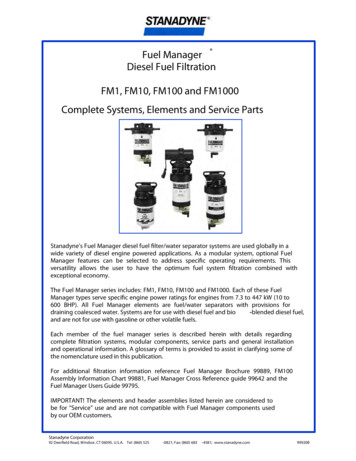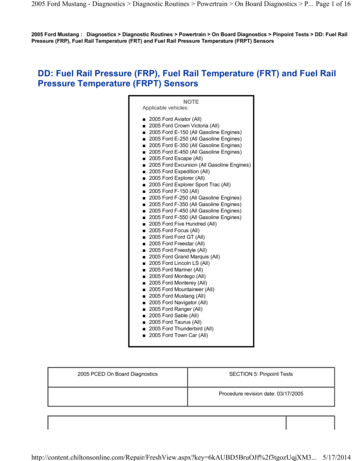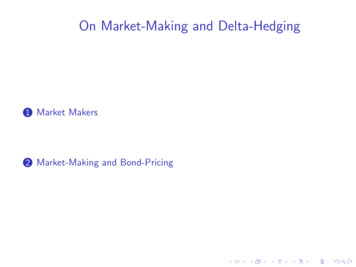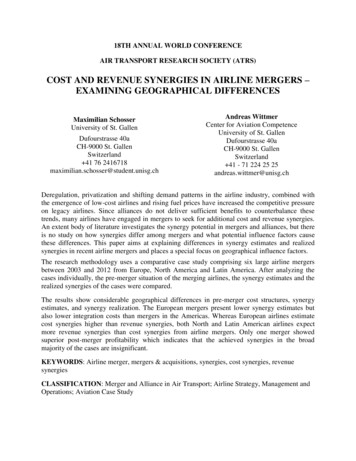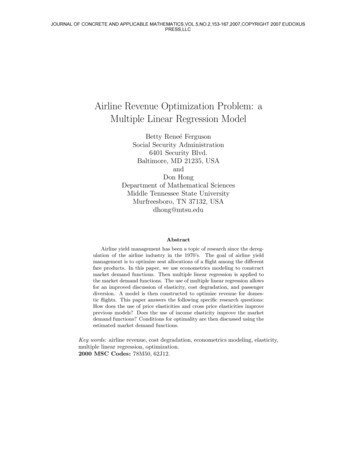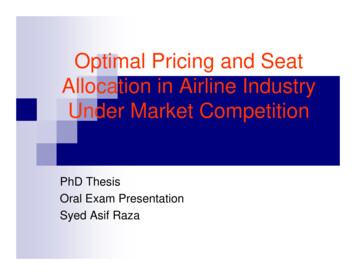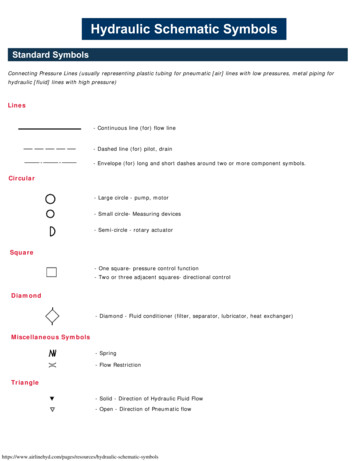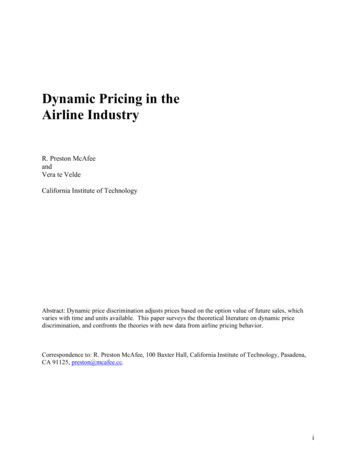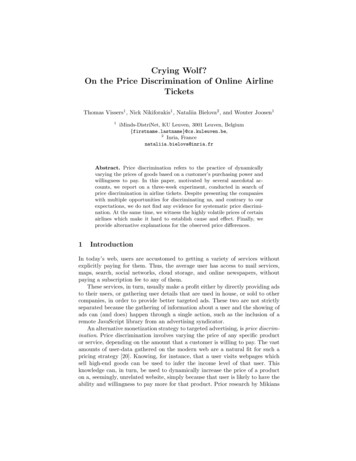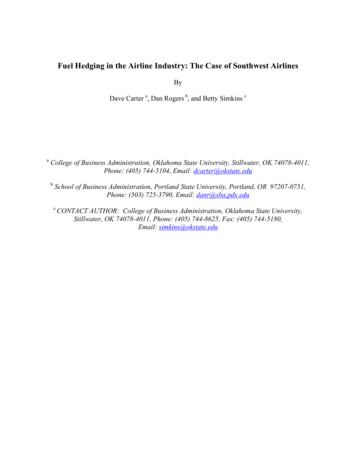
Transcription
Fuel Hedging in the Airline Industry: The Case of Southwest AirlinesByDave Carter a, Dan Rogers b, and Betty Simkins caCollege of Business Administration, Oklahoma State University, Stillwater, OK 74078-4011,Phone: (405) 744-5104, Email: dcarter@okstate.edubSchool of Business Administration, Portland State University, Portland, OR 97207-0751,Phone: (503) 725-3790, Email: danr@sba.pdx.educCONTACT AUTHOR: College of Business Administration, Oklahoma State University,Stillwater, OK 74078-4011, Phone: (405) 744-8625, Fax: (405) 744-5180,Email: simkins@okstate.edu
Fuel Hedging in the Airline Industry: The Case of Southwest AirlinesByDave Carter, Dan Rogers, and Betty Simkins“If we don’t hedge jet fuel price risk, we are speculating. It is our fiduciary duty to try andhedge this risk.”Scott Topping, Director of Corporate Finance for Southwest AirlinesJune 12, 2001: Scott Topping, the Director of Corporate Finance for Southwest Airlines(hereafter referred to as “Southwest”), was concerned about the cost of fuel for Southwest. Highjet fuel prices over the past 18 months had caused havoc in the airline industry. Scott knew thatsince the industry was deregulated in 1978, airline profitability and survival depended oncontrolling costs.1 After labor, jet fuel is the second largest operating expense for airlines. Ifairlines can control the cost of fuel, they can more accurately estimate budgets and forecastearnings.It was Scott’s job to hedge fuel costs, however, he knows that jet fuel prices are largelyunpredictable. As shown in Figure 1, jet fuel spot prices (Gulf Coast) have been on an overallupward trend since reaching a low of 28.50 cents per gallon on December 21, 1998. OnSeptember 11, 2000, the Gulf Coast jet fuel spot price was 101.25 cents/gallon – a whoppingincrease of 255 % in the spot price since the low in 1998. The prior day’s (June 11, 2001) spotprice for Gulf Coast jet fuel closed at a price of 79.45 cents/gallon. While this price was lowerthan the highest level, Scott knew that future jet fuel prices would be uncertain.Figure 2 illustrates the high volatility of jet fuel prices. As shown, historical daily volatility overa recent 25-day period for Gulf Coast has averaged 58.7 percent.2 Clearly, fuel price risk is animportant concern for airlines.1One of the most important events in the history of the airline industry was the Deregulation Act passed by U.S.Congress in 1978. This act removed all government controls over fares and domestic routes for the first time andgave airlines the opportunity to operate as true businesses.2For example, at the price of 79.45 cents/gallon for jet fuel, there is a 68% probability that the price will change byas much as /-46.63 cents/gallon (i.e. 79.45 x 0.587). This means that there is a 68 percent probability that the pricewill range from 32.8 to 126.0 cents/gallon. Using a recent 10-week average volatility of 30.5% (data not shown),1
As a result of fuel price increases during the later half of 1999 and throughout 2000, Southwest’sfuel and oil expense per available seat-mile (ASM) for the year 2000 increased 44.1 percent overthat for 1999.3 As shown in Table 1, Southwest’s average price per gallon of jet fuel in 2000 was 0.7869 compared to 0.5271 in 1999.4About Southwest AirlinesSouthwest was formed in 1971 by Rollin King and Herb Kelleher and the airline began withthree Boeing 737 aircraft serving the Texas cities -- Dallas, Houston, and San Antonio. Theairline began with one simple strategy: “If you get your passengers to their destinations whenthey want to get there, on time, at the lowest possible fares, and make darn sure they have a goodtime doing it, people will fly your airline.”5 This strategy has been the key to Southwest’ssuccess. The airline realized early on that air travel would become a commodity business.In May 1988, Southwest became the first airline to win the coveted Triple Crown for a month –Best On-time Record, Best Baggage Handling, and Fewest Customer Complaints. Since then,the airline has won five annual Triple Crowns: 1992, 1993, 1994, 1995, and 1996. In addition tobeing a top quality airline, Southwest was also innovative. They were the first airline with afrequent flyer program to give credit for the number of trips taken and not the number of milesflown. Additionally, they pioneered senior discounts, same-day airfreight delivery service,ticketless travel, and many other unique programs.By the year 2000, the small Texas airline had evolved to become the 4th largest U.S. carrierbased on domestic passengers boarded and the largest U.S. carrier based on scheduled domesticdepartures. At year-end 2000, Southwest operated 344 Boeing 737 aircraft and provided serviceto 58 airports in 57 cities in 29 states throughout the U.S. In 2000, Southwest commencedservice to Albany and Buffalo, New York, and in January 2001, to West Palm Beach, Florida.Tables 2 and 3 provide Southwest Airlines’ consolidated statement of income and consolidatedbalance sheet, respectively, for the years 1999 and 2000. Historically, Southwest hasexperienced some seasonality in their business. For example, quarterly operating income and, toa lesser extent, revenues tend to be lower in the first quarter. In 2000, quarterly operatingincome represented 22 percent of annual operating income.Fuel Hedging in the Airline Industrythere is a 68% probability that the price will change by as much as 24.23 cents/gallon. Given that Southwest spent 484.7 million on jet fuel in the year 2000, there is a 68 % change that jet fuel can fluctuate by as much as 147.8million using the 10 week volatility average (i.e. 0.303 x 484.7 million).3See the appendix for a glossary of airline terms.4These prices are net of the following gains from hedging -- approximately 113.5 million in 2000 and 14.8million in 1999.5Refer to “We Weren’t Just Airborne Yesterday”, Southwest Airlines – A Brief History,http://www.southwest.com/.2
Airlines executives know that it is often impossible to pass higher fuel prices on to passengers byraising ticket prices due to the highly competitive nature of the industry. Because large airlinescompete with one another on most of the routes they serve, they have little power to raise pricesin response to higher fuel costs. For example, Continental Airlines rescinded a fare hike aftertrying a number of times to boost overall fares. The airline said the airfare increases were due tohigh fuel costs, but intense airline competition has left the firm unable to pass along fuel costs tocustomers.6Table 4 provides information on competition in the airline industry for both passenger airlines(Panel A) and airfreight carriers (Panel B). As shown in Panel A, Southwest Airlines holds a5.51% market share based on total available seat miles flown over the period 1994-2000. Overthe same period, Southwest holds a much smaller share of the freight market (see Panel B). By2000, Southwest was the fourth largest carrier in the US based on passengers flown and thelargest based on departures (see previous section). Obviously, competition is a top concern forSouthwest. With air travel becoming a commodity business, being competitive on price is thekey to survival and success. As Warren Buffett states: “You cannot be the high-cost producer ina commodity business. Sometimes it’s not even any good to be the low-cost producer.”(McCartney, Michaels, and Rogers, 2002).Airlines that want to prevent huge swings in operating expenses and bottom line profitabilitychoose to hedge fuel prices. In fact, Raymond Neidl (see Neidl and Chiprich, 2001) points outthat “the carriers that produced an adequate return, especially in the second half of 2000, tendedto be those that had good fuel hedge positions in place.” Airlines without hedges in place haddisappointing earnings or losses. For example, in the fourth quarter 2000, US Airways, whichwas unhedged, estimated that its 88 million net loss would have been a profit of 38 million iftheir fuel costs had not increased. Airlines are different from most commodity users orproducers in that it usually the airline company’s treasury department (rather than the fuelpurchasers) that handles fuel hedging.Fuel price risk management techniques were adopted by airlines around 1989 (Clubley, 1999).Airlines use derivative instruments based on crude oil, heating oil, or jet fuel to hedge their fuelcost risk. The majority of airlines rely on plain vanilla instruments to hedge their jet fuel costs,including swaps, futures, call options (including average price options which are a type of calloption), and collars (including zero-cost collars).There are two main reasons why several fuels other than jet fuel are used in jet fuel hedging byairlines. The first reason requires a brief explanation of refining. When refiners process crudeoil, the main products are gasoline, middle distillates (heating oil, diesel fuel, and jet kerosene)and residual fuel oil. Refiners often refer to these products as top, middle, or bottom of thebarrel, respectively. Products from the same part of the barrel share similar characteristics, andas a result, the prices are highly correlated.7 Hence, heating oil, which shares similar6See “Continental Raises Domestic Fares, Cites Fuel Costs” (Reuters, February 27, 2004) and “Continental AirlinesResends Latest Fare Hike” (Reuters, June 7, 2004).7Jet fuel is a essentially pure kerosene with some additives. Two products from the barrel not mentioned above arethe gas liquids like butane at the very top and asphalt at the very bottom.3
characteristics to jet fuel, is frequently used in hedging by airlines. Also, since jet fuel is refinedfrom crude oil, crude oil is also used in hedging by airlines due to high price correlation.The second reason why airlines use several fuels in hedging is because jet fuel is not asufficiently liquid market to warrant a futures contract or other type of exchanged-tradedcontract. As a result, derivative contracts for jet fuel must be arranged on the over-the-counter(OTC) markets. However, there are active and liquid markets for exchange-traded contracts oncrude oil and heating oil in New York (the New York Mercantile Exchange, NYMEX) and forgasoil in London (the International Petroleum Exchange, IPE).8 While exchange-traded productsoffer high liquidity and low credit risk, typically these contracts are standardized and inflexible,meaning that users often face large basis risk.The term “basis risk” is used to describe the risk that the value of the commodity being hedgedmay not change in tandem with the value of the derivative contract used to hedge the price risk.While crude oil, heating oil, and jet fuel prices are highly correlated, significant basis risk canemerge if the relationship between the commodities breaks down. In an ideal hedge, the hedgewould match the underlying position in every respect, removing any change of basis risk.However, in actuality, basis risk is a high concern, even if the derivatives contract is for the exactsame commodity being hedge. More specifically, in the futures markets, basis is defined as thedifferential between the cash price of a given commodity and the price of the nearest futurescontract for the same, or a related commodity.9 Hence, basis risk when hedging using futurescontracts refers to the risk of the differential changing over the life of the hedge.Why does basis risk occur? The following three basis risks occur frequently in hedging: productbasis risk, time basis risk, and locational basis risk. Product basis risk occurs when there is amismatch in the quality, consistency, weight, or underlying product. For example, airlinesfrequently use crude oil contacts to hedge jet fuel, but obviously crude oil and jet fuel are twodifferent commodities and hence have large product basis risk. Even within the samecommodity category, such as crude oil, product basis risk occurs because there are many types ofcrude oil varying in viscosity (such as heavy versus light crude) and sulfur content (sweet versussour crude). Time basis risk occurs when there is a mismatch in the time of the hedge. Forexample, if a hedger wishes to hedge long-term but only has short dated contracts available, timebasis risk is very significant.10 Locational basis risk, one of the most common types of basis risk,8Gas oil is the European designation for No. 2 heating oil and diesel fuel.Refer to “A Guide to Energy Hedging” published by the New York Mercantile Exchange.10For one of the most famous examples of time basis risk, refer to Metallgesellschaft Refining and Marketing(MGRM), which was an American subsidiary of Metallgesellschaft (MG), an international trading, engineering, andchemicals conglomerate. In 1992, MGRM implemented what it believed to be a profitable marketing strategy. Thecompany agreed to sell specified amounts of petroleum products every month, for up to ten years, at fixed prices thatwere higher than the current market price. MGRM then purchased short-term energy futures to hedge the long-termcommitments - a "stack" hedging strategy. This timing mismatch caused MGRM to go bankrupt. The MGRM hedgealso illustrates another type of hedging risk: "funding risk" - the risk that positions which may be profitable in thelong run can bankrupt a company in the short run if negative cash flows are mismatched with positive cash ertohttp://www.erisk.com/Learning/CaseStudies/ref case mg.asp.94
occurs when there is a mismatch in the price of the product from one location to another, amismatch in the delivery point for the derivatives contract, among others.While such extreme breakdowns in correlations are rare, hedgers should be aware of basis risk.Julian Barrowcliffe, director of global commodity swaps at Merrill Lynch (Schap, 1993) stated:“Some of the largest hedging losses have resulted from the assumption that heating oil and jetkerosene were essentially the same product and
About Southwest Airlines Southwest was formed in 1971 by Rollin King and Herb Kelleher and the airline began with three Boeing 737 aircraft serving the Texas cities -- Dallas, Houston, and San Antonio. The airline began with one simple strategy: “If you get your passengers to their destinations when
